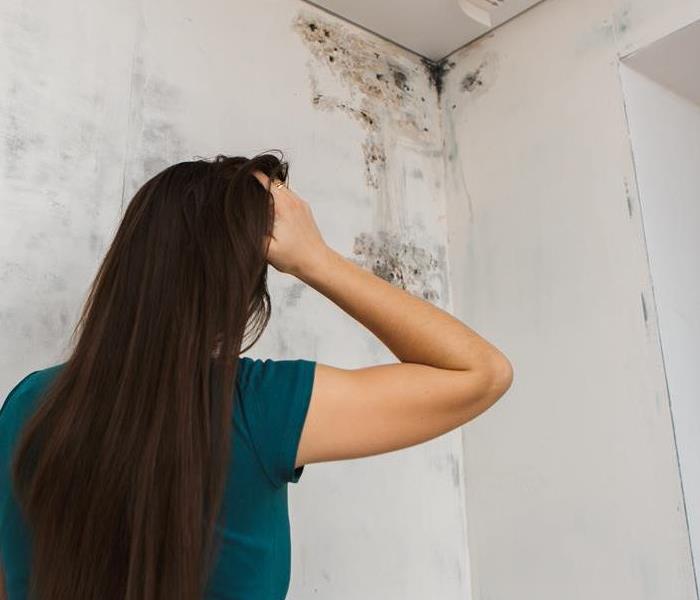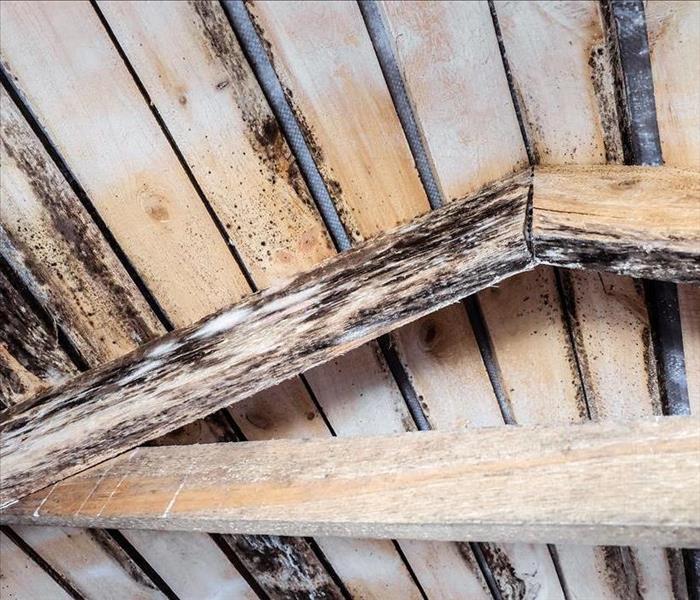Recent Mold Remediation Posts
Mold in Drywall: Identification and Repair
3/20/2024 (Permalink)
Mold in drywall can be a silent intruder, often going unnoticed until it becomes a more significant issue. Understanding how to identify the signs of mold in drywall and implementing effective repair solutions is essential for homeowners. In this blog post, we'll guide you through the identification of mold in drywall and provide practical tips for successful repair.
Recognizing Signs of Mold
Identifying mold in drywall requires a keen eye for subtle signs. Look for discoloration, which may appear as dark spots or patches on the surface. Mold can also manifest as a fuzzy or powdery texture. Musty odors, even if not visibly accompanied by mold, can indicate hidden growth behind the drywall. Regular inspections, especially in areas prone to moisture, can help catch mold early.
Investigating Water Sources
Mold thrives in moist environments, making water sources a crucial factor in its growth. Investigate and address any potential water leaks or sources of moisture near affected drywall areas. This may include roof leaks, plumbing issues, or even inadequate ventilation. Fixing these water sources is a fundamental step in preventing mold recurrence.
DIY Mold Testing Kits
If you suspect mold in your drywall, you can use DIY mold testing kits available in the market. These kits can help identify the presence of mold and provide insights into the severity of the issue. While these kits may offer preliminary information, it's essential to consult with professionals, like SERVPRO®, for a thorough assessment and accurate diagnosis.
Professional Mold Inspection
For a comprehensive evaluation of mold in drywall, consider hiring professionals for a mold inspection. Certified experts have the experience and tools to assess the extent of mold growth, identify hidden issues, and develop a tailored plan for remediation. Professional inspection ensures a thorough understanding of the mold situation and allows for effective repair strategies.
Effective Mold Remediation
Once mold is identified in drywall, effective remediation is crucial. Professional mold remediation services, like those offered by SERVPRO, involve thorough removal of affected drywall, cleaning of surfaces, and application of mold-resistant treatments. Professional remediation ensures that mold is eradicated, preventing its recurrence and safeguarding the integrity of your drywall.
Drywall Replacement
In cases of extensive mold damage, drywall replacement may be necessary. Professional restoration services can assess the severity of the situation and determine whether partial or complete replacement is required. High-quality materials and expert installation ensure that your new drywall is resistant to mold growth.
Preventative Measures
Preventing mold in drywall involves implementing preventative measures. Ensure proper ventilation in areas prone to moisture, such as bathrooms and kitchens. Repair any leaks promptly, and use mold-resistant drywall when installing or replacing drywall. Taking these preventative steps helps create an environment less conducive to mold growth.
Regular Maintenance
Routine maintenance is key to preventing and addressing mold issues. Keep an eye on your drywall for any signs of discoloration or unusual textures. Address water leaks immediately, and conduct regular inspections in moisture-prone areas. Proactive maintenance contributes to early detection and effective mold prevention.
Identifying and repairing mold in drywall requires a proactive approach. Regular inspections, prompt addressing of water sources, and professional remediation services are essential components of successful mold management. Trust SERVPRO for expert assistance in assessing and repairing mold in your drywall, ensuring a thorough and effective restoration process. By staying vigilant and taking proactive measures, you can protect the integrity of your drywall and maintain a mold-free home environment.
Mold Testing: When and How to Do It Right
10/24/2023 (Permalink)
 Mold testing is critical in identifying the type of mold and correct treatment options.
Mold testing is critical in identifying the type of mold and correct treatment options.
Mold growth is a common issue that can negatively impact homes' structural integrity and aesthetic appeal. If left untreated, mold can lead to costly repairs and pose potential risks to homeowners' health. The importance of mold testing in preventing and treating mold growth cannot be overstated. In this blog, we will explore when and how to properly carry out mold testing to explicitly identify and address mold growth in homes.
Signs of Mold Growth
Mold growth is visible on surfaces such as walls, floors, and ceilings. It often appears as black or green patches and can emit a musty odor. However, not all mold growth is visible, and it may be present in areas such as air ducts, inside walls or beneath flooring. In such cases, identifying mold growth is difficult without specialized testing. Additionally, after experiencing water damage, such as floods or leaks, mold growth may be present but not yet visible. Prompt action is needed to prevent mold growth or identify it before it spreads.
When to Test for Mold
Mold testing is not always necessary, but it is essential in certain circumstances. If homeowners experience a persistent musty odor or suspect mold growth, they should consider testing. Additionally, after water damage or flooding, mold testing can help identify potential hidden mold growth and prevent further damage. Homeowners seeking to purchase new homes should also consider mold testing to assess the quality of the property. Mold testing can also be useful in detecting mold types that may be more hazardous, such as black mold.
How to Test for Mold
Mold testing requires expertise to properly identify mold types and concentrations. The most common methods of mold testing include air testing, surface testing, and bulk testing. Air testing assesses mold spore concentrations in the air and is useful in detecting hidden mold growth. Surface testing involves testing visible patches of mold and determining the mold type. Bulk testing involves taking samples of materials suspected of harboring mold, such as drywall or flooring. Professional mold testing services are recommended for accurate testing and identification.
DIY Mold Testing Kits
For those who prefer a do-it-yourself approach, mold testing kits are available on the market. These kits typically include swabs, petri dishes, or air sampling cassettes for collecting samples. While these kits can provide initial results, it's important to note that their accuracy and reliability may vary. DIY mold testing kits may not identify the specific type or concentration of mold accurately. If using a DIY kit, it is advisable to also seek professional advice to interpret the results correctly. Consulting with mold remediation experts can help homeowners understand and take appropriate action based on the test results.
Mold testing is critical in identifying and treating mold growth in homes. Homeowners should be vigilant in watching out for signs of mold growth and consider testing when there is a suspicion of mold or experiencing water damage. Engaging professional services is recommended for accurate testing and effective remediation measures to address mold growth.
Everything You Need to Know About Black Mold
5/16/2023 (Permalink)
 Black mold is a serious issue that can pose a threat to the structural integrity of a building and the building occupants.
Black mold is a serious issue that can pose a threat to the structural integrity of a building and the building occupants.
Black mold, also known as Stachybotrys chartarum, is a type of mold that can grow in damp and humid environments. This type of mold is often associated with water damage and can pose a serious threat to the structural integrity of a building. In this blog, we will explore everything you need to know about black mold, including how it grows, where it can be found, and how to prevent it.
What is Black Mold?
Black mold is a type of fungus that grows in damp and humid environments. It is often found in areas that have been affected by water damage, such as leaky roofs or pipes. Black mold is known for its dark color and musty smell. It can cause serious damage to buildings and can pose a threat to the building occupants.
Where is Black Mold Found?
Black mold can be found in a variety of environments, but it is most commonly found in areas that have been affected by water damage. This includes areas such as basements, bathrooms, and kitchens. Black mold can also grow in areas where there is poor ventilation, such as crawl spaces and attics.
How Does Black Mold Grow?
Black mold grows in damp and humid environments. It requires moisture to grow and can thrive in areas where there is poor ventilation. Black mold can grow on a variety of surfaces, including wood, drywall, and carpet. It can also grow on organic materials such as paper and fabrics.
How to Prevent Black Mold
Preventing black mold starts with controlling moisture in the building. This includes fixing leaky pipes, repairing roofs, and ensuring proper ventilation in areas such as bathrooms and kitchens. Regular inspections of the building can also help to identify areas where moisture may be present and prevent the growth of black mold. Additionally, it is important to clean up any water damage promptly and thoroughly to prevent the growth of mold.
How to Remove Black Mold
If black mold is present in a building, it is important to have it removed promptly and properly. This typically involves hiring a professional mold remediation company, such as our SERVPRO of East Greenwich/Warwick team. The remediation process may include containment to prevent the spread of mold spores, removal of affected materials, and thorough cleaning of the area. It is important to ensure that the source of the moisture that caused the mold growth is also addressed to prevent future growth.
In conclusion, black mold is a serious issue that can pose a threat to the structural integrity of a building and the building occupants. It is important to understand how black mold grows, where it can be found, and how to prevent it. If black mold is present, it is important to have it removed promptly and properly to prevent further damage and protect the health of everyone in the building. By following proper prevention and remediation techniques, building owners can ensure a safe and healthy environment for everyone.




 24/7 Emergency Service
24/7 Emergency Service

